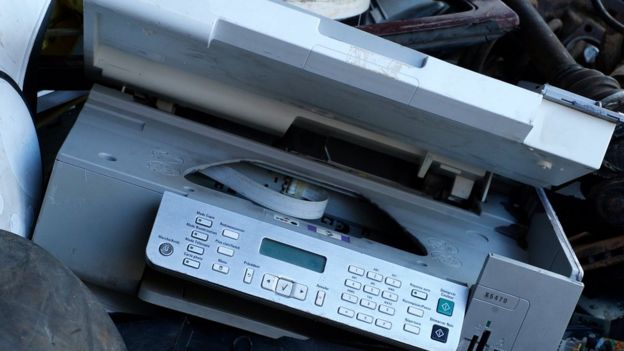Togo imports an estimated 500,000 tonnes of e-waste a year, some of it can be a health hazard, but it also inspires local innovators and provides jobs.

It looks like a spider and it moves like one, but this robot creature cannot just be dismissed as a toy.
It is also a symbol of the digital revolution brewing in one of West Africa's smallest countries.
"I made this from a [discarded] 3D printer," Ousia Foli-Bebe says, pointing as his robotic arachnid.
"The plastic retrieved from the printer became the arms and legs. And I made a 3D printer as well from e-waste. I actually learned how to make the printer from the internet," he adds.
Mr Foli-Bebe takes the robot spider into schools hoping to interest the students in science and recycling.
"My hope is to make a science kit so that they can begin to make their own things and solve the problems of this community," the inventor says.
His Ecotec lab is situated in Amadanhome on the outskirts of Togo's capital, Lomé.
It is a modest space, with a blackboard dominating one wall and a 3D printer next to the opposite wall.
The 29-year-old is one of a growing number of young entrepreneurs who see all the e-waste imported by Togo as an opportunity.
Local environmental body E-Waste Centre estimates that 500,000 tonnes come into the country every year.
Outside his lab is a motley collection of old televisions and other used electronic goods spread over a tennis-court-sized dumpsite.
Conveniently, Mr Foli-Bebe shares the site with an e-waste recycler, giving easy access to parts for his inventions.
He admits he has learned a lot about recycling from others such as Gnikou Afate, who is credited with having made the first 3D printer in Togo.
So impressive was Mr Afate's homemade printer that it took first place at the Barcelona Fabrication Technology conference in 2015.
The soft-spoken 39-year-old innovator, who previously used to collaborate with another technology hub called Woelab, one of the best in town, recently started his own lab and operates out of a small workspace next to his house.
The new 'goldmine'
"At first, electronic waste was a plague - that's how we used to describe it," Mr Afate says.
"Our streets were littered with old computer bodies rotting away. But today that problem has turned into an opportunity. E-waste could be described as a goldmine."
Only 41 countries in the world, , most of them European, collect statistics on e-waste, according to The Global E-waste Monitor report.
In 2016 people around the world generated about 44 million tonnes of electronic waste, the report said.
Old mobile phones, laptops, TVs and generators jammed inside vans and lorries form part of what comes through Lomé's port.
The vehicles are opened up at a market next door to the port and the buyers gather round.
The rising demand for technology has created a market for people who want to buy second-hand electronics at bargain prices.
But it is not just demand for these products that is encouraging their arrival. It is also the inadequate recycling available in richer countries.
Organisations such as the Basel Action Network are raising concerns that Western countries are simply not handling their own electronic waste effectively, leaving it destined to end up on cargo ships bound for West Africa, among other places.
"The world does not know what to do with the e-waste that it is producing. Africa offers the best environment for dumping," says activist Sena Alouka from Youth for the Environment Togo.
"We have a weak regulatory framework, weak institutions and corruption also aids in the movement of e-waste. We need to emulate Thailand who threatened to use her military to ban the import of electronic waste."
While it is not against international law to export used goods to other countries, the problem comes about if these goods no longer work as outlined by treaties such as the Basel and Bamako conventions.
The Bamako convention, which came into force in 1998, commits African nations to banning the importation of hazardous waste, including radioactive material.
It also encourages countries on the continent to adopt legislation to control the importation of near-end-of-life or unwanted equipment by designating such equipment as hazardous waste.
"Think of a set of televisions - they have cadmium, lead and beryllium. All those are toxic and very dangerous to humans and to the environment," Mr Alouka says.
"They can find their way to aquifers, spill into the ocean. We eat the fish. They contain mercury and much more. [It is] very dangerous for our health. Especially to our children."
It is, however, a challenge to regulate electronic waste management because many people earn a living from it.
"If you look at the types of waste which arrives here, a lot of it is highly dangerous and toxic so we should really evaluate the economic impact that it could have on our environment," Hervé Tchamsi from the E-Waste Centre, a recycling business, says.
His team tries to minimise their exposure to the hazardous materials in the e-waste and he hopes this higher standard will one day be the norm in Togo.
Sent back to Europe
But for now, what they cannot repurpose, they export back to Europe, where it originally came from. An irony that is not lost on Mr Tchamsi.
"Here are the TVs that contain the toxic materials. We pay to send these back to Belgium for recycling - because we do not have the capacity here to recycle the e-waste in a safe way," he explains.
In a country with limited job opportunities for its young people there is huge potential for this industry.
Innovators and entrepreneurs alike are trying to come up with solutions that harness that potential and mitigate the dangers.
By Waihiga Mwaura
BBC NEWS
You can now watch some interesting videos and pictures published by BBC News clicking here:

No hay comentarios:
Publicar un comentario